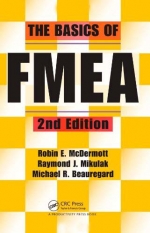Originally designed to address safety concerns, Failure Mode and Effect Analysis (FMEA) is now used throughout the industry to prevent a wide range of process and product problems. Useful in both product design and manufacturing, FMEA can identify improvements early when product and process changes are relatively easy and inexpensive to make.Updated to include changes reflected in ISO/TX-16949:2002 standards and 2008 AIAG guidelines, The Basics of FMEA, Second Edition continues to provide the expert advice needed to help shorten the learning curve for FMEA teams to conduct effective and efficient FMEAs, even if it is their very first one.Using a manufacturing case study, readers learn step-by-step how to use FMEAs to assess, evaluate, and prioritize areas of risk, and then to implement the actions needed to reduce risks to an acceptable level. It shows the steps needed to ferret out potential problems and prevent making inferior products that could endanger public and worker safety and compromise profits as well as the future of all stakeholders.Although engineers have typically analyzed processes and products for potential failures, the FMEA process standardizes the approach and establishes a common language that nontechnical as well as technical employees can use at all levels. Unlike other improvement tools, FMEA does not require complicated statistics. However, they require a full commitment to quality and a willingness to take a team approach that involves all stakeholders.
Foreword
About the Author
Introduction
Chapter 1 : Strategy Alignment
Chapter 2 : Project Identification
Chapter 3 : Lean Six Sigma Basics
Chapter 4 : Kaizen Event Planning
Chapter 5 : Data Collection and Analysis
Chapter 6 : Process Improvement
Chapter 7 : Building a Business Case for Change
Chapter 8 : Implementing Solutions
Chapter 9 : Reinforcing New Behaviours and Organzational Change
Conclusion
Appendix
Glossary
Index

























